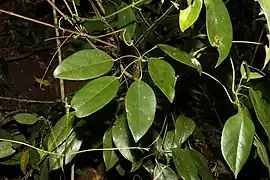| Climbing umbrella tree | |
|---|---|
 | |
| Scientific classification | |
| Kingdom: | Plantae |
| Clade: | Tracheophytes |
| Clade: | Angiosperms |
| Clade: | Eudicots |
| Clade: | Asterids |
| Order: | Apiales |
| Family: | Araliaceae |
| Genus: | Heptapleurum |
| Species: | H. ellipticum |
| Binomial name | |
| Heptapleurum ellipticum | |
| Synonyms[3] | |
Heptapleurum ellipticum, commonly known in Australia as the climbing umbrella tree, is a plant in the family Araliaceae native to the Indian subcontinent, Indochina, Malesia, Papuasia and Australia.
Description
The climbing umbrella tree is a vine or scandent shrub growing up to 10 m (33 ft) high and a stem diameter of up to 9 cm (3.5 in).[4][5]
The alternately arranged leaves have a petiole measuring 4 to 14 cm (1.6 to 5.5 in) long.[4][5][6] They are compound with 4 to 7 leaflets arranged palmately.[5] Each leaflet measures around 6 to 18 cm (2.4 to 7.1 in) long by 2.5 to 10 cm (0.98 to 3.94 in) wide.[4][5][6] They are leathery and glabrous with usually 5-6 pairs of secondary veins.[6]
The inflorescence is about 24 cm (9.4 in) long,[4][6] with flowers arranged in umbels. The globose fruit are very small, about 4–6 mm (0.16–0.24 in) in diameter.[4][6]
Taxonomy
This species was first described as Sciodaphyllum ellipticum in 1826 by the Dutch botanist Carl Ludwig Blume, based on material collected near Mount Salak, Indonesia.[7] In 1865 it was transferred to the genus Heptapleurum by Berthold Carl Seemann,[8] then to Schefflera by Hermann Harms in 1894,[9] where it remained for more than a century. In 2020 Porter P. Lowry II and Gregory M. Plunkett published a paper in which they resurrected the genus Heptapleurum and transferred a large number of species − including this one − to it from Schlefflera.[10]
Distribution and habitat
The natural range of the climbing umbrella tree is from India through Southeast Asia and Southern China, Melanesia, Papuasia, Christmas Island and northern Australia.[3][4][5] In Australia it is restricted to the northeastern parts of Queensland.[4][11] It grows in mainly in rainforest and gallery forest from near sea level up to 2,500 m (8,200 ft).[4][5][6]
Uses
The plant has been used in traditional medicine as a treatment for a number of ailments, including coughs, edema, toothache and wounds.[5]
Gallery
 Foliage
Foliage Fruit
Fruit Stems coiled on the ground
Stems coiled on the ground Cross section of stem
Cross section of stem
References
- ↑ "Species profile—Heptapleurum ellipticum". Queensland Department of Environment and Science. Queensland Government. 2022. Retrieved 25 March 2023.
- ↑ Li, R.; Qin, h.; Botanic Gardens Conservation International (BGCI).; IUCN SSC Global Tree Specialist Group. (2019). "Heptapleurum ellipticum". IUCN Red List of Threatened Species. 2019: e.T144056634A147644168. doi:10.2305/IUCN.UK.2019-2.RLTS.T144056634A147644168.en. Retrieved 20 February 2023.
- 1 2 3 "Heptapleurum ellipticum (Blume) Seem". Plants of the World Online. Royal Botanic Gardens, Kew. Retrieved 20 February 2023.
- 1 2 3 4 5 6 7 8 F.A.Zich; B.P.M.Hyland; T.Whiffen; R.A.Kerrigan (2020). "Heptapleurum ellipticum". Australian Tropical Rainforest Plants Edition 8 (RFK8). Centre for Australian National Biodiversity Research (CANBR), Australian Government. Retrieved 20 February 2023.
- 1 2 3 4 5 6 7 "Heptapleurum ellipticum (Blume) Seem". Flora and Fauna Web. Singapore Government. Retrieved 25 March 2022.
- 1 2 3 4 5 6 "Schefflera elliptica (Blume) Harms in Engl. & Prantl, Nat. Pflanzenfam. 3(8): 39. 1894". Flora of China (eFloras). Missouri Botanical Garden, St. Louis, MO & Harvard University Herbaria, Cambridge, MA. Retrieved 20 February 2023.
- ↑ Blume, Carl Ludwig (1825). Bijdragen tot de flora van Nederlandsch Indië. Vol. 15. Batavia. p. 878.
- ↑ "Heptapleurum ellipticum". International Plant Names Index (IPNI). Royal Botanic Gardens, Kew. 2021. Retrieved 25 March 2023.
- ↑ "Schlefflera elliptica". International Plant Names Index (IPNI). Royal Botanic Gardens, Kew. 2021. Retrieved 25 March 2023.
- ↑ Porter P. Lowry II; Gergory M. Plunkett (2020). "Resurrection of the Genus Heptapleurum for the Asian Clade of Species Previously Included in Schefflera (Araliaceae)". Novon: A Journal for Botanical Nomenclature. 28 (3): 143–170. doi:10.3417/2020612. S2CID 221860194.
- ↑ "Search: species: Heptapleurum ellipticum | Occurrence records". Australasian Virtual Herbarium. Australian Government. Retrieved 25 March 2023.
External links
 Data related to Heptapleurum ellipticum at Wikispecies
Data related to Heptapleurum ellipticum at Wikispecies Media related to Heptapleurum ellipticum at Wikimedia Commons
Media related to Heptapleurum ellipticum at Wikimedia Commons- View a map of historical sightings of this species at the Australasian Virtual Herbarium
- View observations of this species on iNaturalist
- View images of this species on Flickriver
